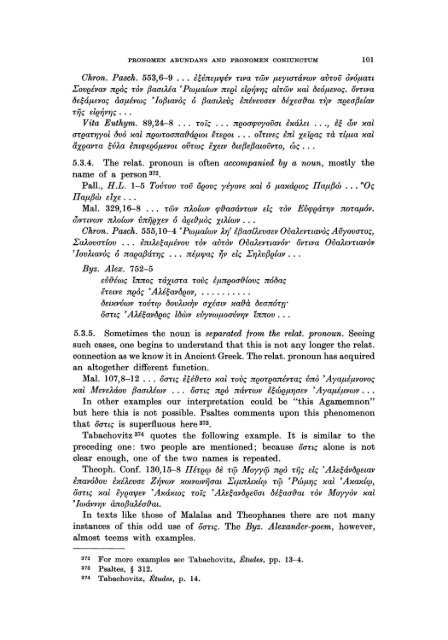Pronomen Abundans and Pronomen Coniunctum. A ... - DWC
Pronomen Abundans and Pronomen Coniunctum. A ... - DWC
Pronomen Abundans and Pronomen Coniunctum. A ... - DWC
You also want an ePaper? Increase the reach of your titles
YUMPU automatically turns print PDFs into web optimized ePapers that Google loves.
PRONOMEN ABUNDANS AND PRONOMEN CONIUNCTUM 101<br />
Chron. Paseh. 553,6-9 ... UénefJ/lpév nva TlVV fl-eyun:ávwv a1TrOV ov6fl-an<br />
Eov(!évav n(!oç TOV fJaalÄéa • PWfl-alwv ne(!l el(!~v'YJç alTwv "al be6fl-evoç. 8vnva<br />
be~áfl-evoç àafl-évwç , IofJtavoç ó fJaalÀevç ènévevaev béxw{}al T~V n(!wf3elav<br />
Tijç el(!~v'YJç. . .<br />
Vita Euthym. 89,24-8 ... Toîç ... n(!oacpvyovat è"áÀBl ..., è~ mv "at<br />
aT(!aT'YJyol bvo "al n(!WTOana{}á(!wl [-re(!Ol ... oZnveç èni xeî(!aç Tà Tlfl-la "ai<br />
äx(!avra ~vÀa ènupe(!6fl-eVOl oi5Twç ëXBlV blefJef3awvvTo, wç . ..<br />
5.3.4. The relat. pronoun is of ten accompanied by a noun, mostly the<br />
name of a person 372.<br />
Pall., H.L. 1-5 TOVTOV TOV O(!OVÇ yéyove "al Ó fl-a"á(!wç IJafl-fJw ... "Oç<br />
IJafl-fJw elXe . ..<br />
Mal. 329,16-8 ... TWV nÀolwv q;{}aaávTwv elç TOV Evq;(!áT'YJV nOTafl-6v.<br />
mvnvwv nÀolwv vnij(!xev ó à(!l{}fl-OÇ XlÀtWV . ..<br />
Chrono Paseh. 555,10-4 'Pwfl-alwv À'YJ' èfJaalÀevaev OvaÀevnavoç AvyovaToç,<br />
EaÀovaTlov ... èmÀe~afl-évov TOV aVTov OvaÀevnav6v- 8vnva OvaÀevnavov<br />
, IovÀtavoç ó na(!afJáT'YJç ... néf11paç 1}v elç E'YJÀvf3(!lav . ..<br />
Byz. Alex. 752-5<br />
ev{}éwç 'lnnoç TáXlara TOVÇ èf1n(!oa{}lovç n6baç<br />
lTelve n(!oç , AU~avb(!ov, ......... .<br />
bBl"VVWV TOVTlp bOVÀl"~V axéatv "a{}à bean6Tn·<br />
öanç , AU~avb(!oç lbwv evyvwfl-oaVv'YJv 'lnnov . ..<br />
5.3.5. Sometimes the noun is separated trom the relat. pronoun. Seeing<br />
such cases, one beg ins to underst<strong>and</strong> that this is not any longer the relat.<br />
connection as we know it in Ancient Greek. The relat. pronoun has acquired<br />
an altogether different function.<br />
Mal. 107,8-12 ... 8anç è~é{}BTO "al TOVÇ n(!oT(!anévTaç vno' Ayaf1éf1vovoç<br />
"at'M. eVBJ!.aov l' fJ aal/" 1 .. ewv... ' oanç " n(!o " naVTWV er;;W(!f1'YJaev , t ' 'A' yaf1ef1vwv ...<br />
In other examples our interpretation could be "this Agamemnon"<br />
but here this is not possible. Psaltes comments upon this phenomenon<br />
that 8anç is superfluous here 373.<br />
Tabachovitz 374 quotes the following example. It is similar to the<br />
preceding one: two people are mentioned; because 8anç alone is not<br />
clear enough, one of the two names is repeated.<br />
Theoph. Conf. 130,15-8 IJ Ü(!CP bè Tlp Moyyip n(!o TijÇ elç , AÀe~ávb(!BlaV<br />
ènav6bov è"üevae Z~vwv "Olvwvijaal Elf1nÀl"tcp Tip • PWf1'YJç "ai ' A"a"üp,<br />
8anç "al ey(!a1pev ' A"á"wç Toîç , AÀe~avb(!eVal bé~aa{}al TOV Moyyov "al<br />
, Iwávv'YJv ànofJaUa{}al.<br />
In texts like those of Malalas <strong>and</strong> Theophanes there are not many<br />
instanees of this odd use of 8anç. The Byz. Alex<strong>and</strong>er-poem, however,<br />
almost teems with examples.<br />
372 For more examples see Tabachovitz, Études, pp. 13-4.<br />
373 Psaltes, § 312.<br />
374 Tabachovitz, Études, p. 14.
















